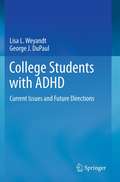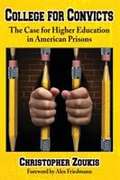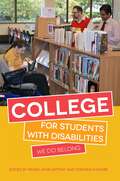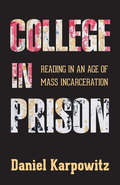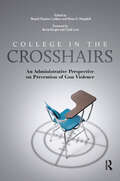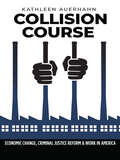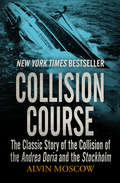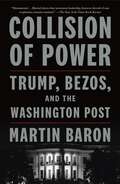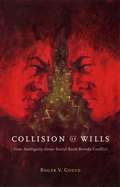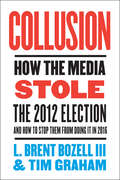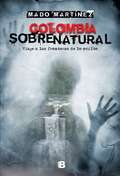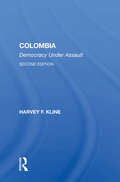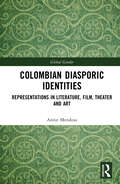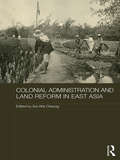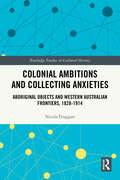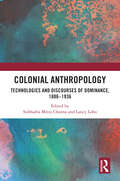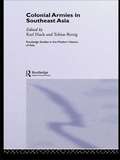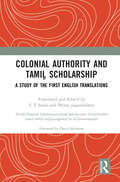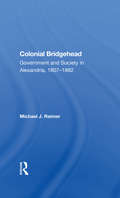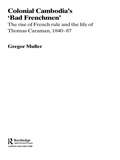- Table View
- List View
College Fight Songs: An Annotated Anthology
by William E Studwell Bruce R SchuenemanGo, team, go! Rah, rah, rah! Boomalacka, boomalacka! Sis-boom-bah! Get your pennants and varsity colors and head for the stadium because College Fight Songs will make you an expert on the musical history of university athletic themes and anthems before the second-half kickoff. Here, in one anthology, you’ll find a unique collection of musical and historical information that hasn’t been compiled and updated since the days of Knute Rockne and the Galloping Ghost. This smart and spirited collection will give you plenty to rise and shout about, bringing together the complete lyrics, brief historical annotations, and musical scores for the songs of over 100 of the country’s most recognized colleges and universities.If you’re a researcher, librarian, musical enthusiast, band leader, musical historian, old-timer from way back when, or a young underclassmen interested in preserving a few cherished notes of your school’s history, College Fight Songs is the book for you. You’ll find plenty of hard-to-find facts about the songs and the people who inspired them, and you’ll get specific information in these areas: complete musical scores of college fight songs full lyrics of college fight songs basic historical background concerning the songs and their institutions information regarding the song creators and the college nicknamesSo, swing on the Rambling Wreck from Georgia Tech, rally around the bonfire and give a holler for the Buckeyes, the Wildcats, the Sooners, the Boilermakers, and the Tigers! The Gipper, the Bear, and Johnny U await you in this fabulous compendium of nostalgia and musical scores. Even after a few pages, College Fight Songs will have you hailing your alma mater and jumping in the car to head for the hop.
College Girls: Bluestockings, Sex Kittens, and Co-eds, Then and Now
by Lynn Peril<P> The author of Pink Think takes on a twentieth-century icon: the college girl. <P> A geek who wears glasses? Or a sex kitten in a teddy? This is the dual vision of the college girl, the unique American archetype born when the age-old conflict over educating women was finally laid to rest. College was a place where women found self-esteem, and yet images in popular culture reflected a lingering distrust of the educated woman. Thus such lofty cultural expressions as Sex Kittens Go to College (1960) and a raft of naughty pictorials in men’s magazines. <P> As in Pink Think, Lynn Peril combines women’s history and popular culture—peppered with delightful examples of femoribilia from the turn of the twentieth century through the 1970s—in an intelligent and witty study of the college girl, the first woman to take that socially controversial step toward educational equity.
College Students in Distress: A Resource Guide for Faculty, Staff, and Campus Community
by Bruce SharkinBe prepared to deal with campus situations that involve students in emotional crisisCollege Students in Distress provides college personnel with invaluable information on how to identify and refer emotionally troubled students for professional counseling. Dr. Bruce S. Sharkin, a staff psychologist at Kutztown University in Pennsylvania, addresses general warning signs of student distress, symptoms of specific psychological problems such as anxiety and depression, guidelines for interventions, and methods of making a referral for counseling. The book also examines current mental health issues for college students and provides an overview of common campus policies and procedures, such as psychological emergencies, withdrawal and readmission, and mandatory counseling. College Students in Distress provides the answers you need to manage difficult-and potentially dangerous-situations on campus. Case examples based on real-life experiences give you a clear sense of what can happen when responding to students in emotional distress, particularly when dealing with specific issues and student populations, and will help in your efforts to review and/or revise the current practices of your school. This unique book is essential as a resource and referral guide that raises awareness of this growing national problem without being limited to the characteristics of a particular college or university. Topics examined in College Students in Distress include: the impact of mental health problems on academics the roles and functions of college counseling services indicators of emotional disturbance suicidal behavior self-inflicted harm eating disorders guidelines for intervention accommodations for students with psychological disabilities and much moreCollege Students in Distress is a must-read for faculty and staff members, particularly those working in residential life, student health, and public safety, and for administrative offices within student services and student affairs.
College Students with ADHD: Current Issues and Future Directions
by Lisa L. Weyandt George J. DupaulNot long ago, conventional wisdom held that ADHD was a disorder of childhood only--that somewhere during puberty or adolescence, the child would outgrow it. Now we know better: the majority of children with the disorder continue to display symptoms throughout adolescence and into adulthood. It is during the teen and young adult years that the psychological and academic needs of young people with ADHD change considerably, and clinical and campus professionals are not always sufficiently prepared to meet the challenge. College Students with ADHD is designed to bring the professional reader up to speed. The book reviews the latest findings on ADHD in high school and college students, assessment methods, and pharmacological and nonpharmacological interventions. Practical guidelines are included for helping young adults make the transition to college, so they may cope with their disorder and do as well as possible in school and social settings. Coverage is straightforward, realistic, and geared toward optimum functioning and outcomes. Among the topics featured: - Background information, from current statistics to diagnostic issues. - ADHD in high school adolescents. - ADHD in college students: behavioral, academic, and psychosocial functioning. - Assessment of ADHD in college students. - Psychosocial/educational treatment of ADHD in college students. - Pharmacotherapy for college students with ADHD. - Future directions for practice and research. The comprehensive information in College Students with ADHD provides a wealth of information to researchers and professionals working with this population, including clinical and school psychologists, school and college counselors, special education teachers, social workers, developmental psychologists, and disability support staff on college campuses, as well as allied mental health providers.
College for Convicts: The Case for Higher Education in American Prisons
by Christopher ZoukisThis volume presents a workable solution to America's mass incarceration and recidivism problems, and demonstrates that great fiscal benefits arise when modest sums are spent educating prisoners. Prisoner education results in a reduction in crime and social disruption, reduced domestic spending and a rise in quality of life.
College for Students with Disabilities: We Do Belong
by Temple Grandin Stephen M. Shore Ehrin Mchenry Dena Gassner Mitchell Nagler Francine Conway Anita Frey Alyssa L. Conigliaro Chanelle Tyler Best Karleen Haines Sonia Minutella Kelsey Mclaughlin Melissa Mooney Patrick Kelty Pavan John Antony Diana Damilatis Kerry Magro<P>Sharing the personal stories of individuals with disabilities who describe both the challenges and successes of their time in higher education, and with a major section on the findings of broad ranging research into the experiences of such students, the book explores the current situation, what works, and how things can be improved. <P>"You are not college material" or "you don't belong in college" are comments frequently heard by students with disabilities. Despite this, college education is now an expected part of the transition to adulthood for many individuals with disabilities. The book includes practical advice to encourage self-advocacy in students with disabilities, and to support the professionals who are facing the challenges alongside them. <P>Covering cerebral palsy, autism spectrum disorders, intellectual disabilities, and much more, this is vital reading for parents, individuals with disabilities, school teachers, college professors, and professionals working with adults with disabilities.
College in Prison: Reading in an Age of Mass Incarceration
by Daniel KarpowitzOver the years, American colleges and universities have made various efforts to provide prisoners with access to education. However, few of these outreach programs presume that incarcerated men and women can rise to the challenge of a truly rigorous college curriculum. The Bard Prison Initiative is different.College in Prison chronicles how, since 2001, Bard College has provided hundreds of incarcerated men and women across the country access to a high-quality liberal arts education. Earning degrees in subjects ranging from Mandarin to advanced mathematics, graduates have, upon release, gone on to rewarding careers and elite graduate and professional programs. Yet this is more than just a story of exceptional individuals triumphing against the odds. It is a study in how the liberal arts can alter the landscape of some of our most important public institutions giving people from all walks of life a chance to enrich their minds and expand their opportunities. Drawing on fifteen years of experience as a director of and teacher within the Bard Prison Initiative, Daniel Karpowitz tells the story of BPI’s development from a small pilot project to a nationwide network. At the same time, he recounts dramatic scenes from in and around college-in-prison classrooms pinpointing the contested meanings that emerge in moments of highly-charged reading, writing, and public speaking. Through examining the transformative encounter between two characteristically American institutions—the undergraduate college and the modern penitentiary—College in Prison makes a powerful case for why liberal arts education is still vital to the future of democracy in the United States.
College in the Crosshairs: An Administrative Perspective on Prevention of Gun Violence
by Brian O. Hemphill Brandi Hephner LaBancGun violence – whether rampage shootings, homicides or suicides – is a potential reality all campuses have to face. This book provides leaders in higher education – and particularly those in student affairs – with data about past incidents, an analysis of trends, and background on the national debate about gun policies and how they impact colleges, state by state. It importantly raises issues about student psychological development, mental health, and the prevalence of alcohol and substance abuse on campus, to better inform discussion about allowing guns on campus and concealed carry. It concludes by sharing strategies for averting gun-related tragedies, and offering models for responding when they occur, based on lessons learned and best practices. The book addresses concealed carry legislation and its impact on campus policies by state, examining the concerns of administrators as they discharge their duty of care to students and comply with legal and regulatory frameworks. Asking “Are our students developmentally ready to make a morally sophisticated, life-changing decision to use firearms in response to a real or perceived threat?”, it offers important perspectives and scientific data, so far absent from the debate, to shape the ongoing conversation with lawmakers and the public about what it takes to keep college communities safe.In addressing risk and prevention, contributors cover the relationship between violence and mental health, and the need to establish comprehensive strategic plans and a preventative framework that promotes help-seeking for those in need before they reach the point of crisis, as well as a campus-wide risk assessment team, stressing the importance of cultivating a community-wide approach to campus safety by empowering members to report suspicious behavior. They also offer guidance on improving effective behavior intervention and case management processes.The book concludes by outlining best practices, and providing guidance on developing an emergency plan, practicing and testing systems, and creating a robust communications strategy. Individual chapters focus on how small colleges with limited resources can develop effective plans into by partnering with local agencies; as well as on the steps that community colleges – who generally lack resident advisors and residential staff, and whose students are far more dispersed – can take to diminish risk and respond promptly and professionally to a crisis.This is an essential guide for all higher education leaders concerned about preventing violence on our campuses, and a call to action.
Collision Course: Economic Change, Criminal Justice Reform, and Work in America
by Kathleen AuerhahnThis book is about the convergence of trends in two American institutions – the economy and the criminal justice system. The American economy has radically transformed in the past half-century, led by advances in automation technology that have permanently altered labor market dynamics. Over the same period, the U.S. criminal justice system experienced an unprecedented expansion at great cost. These costs include not only the $80 billion annually in direct expenditures on criminal justice, but also the devastating impacts experienced by justice-involved individuals, families, and communities. Recently, a widespread consensus has emerged that the era of “mass incarceration” is at an end, reflected in a declining prison population. Criminal justice reforms such as diversion and problem-solving courts, a renewed focus on reentry, and drug policy reform have as their goal keeping more individuals with justice system involvement out of prisons, in the community and subsequently in the labor force, which lacks the capacity to accommodate these additional would-be workers. This poses significant problems for criminal justice practice, which relies heavily on employment as a signal of offenders’ intentions to live a law-abiding lifestyle. The diminished capacity of the economy to utilize the labor of all who have historically been expected to work presents significant challenges for American society. Work, in the American ethos is the marker of success, masculinity and how one “contributes to society.” What are the consequences of ignoring these converging structural trends? This book examines these potential consequences, the meaning of work in American society, and suggests alternative redistributive and policy solutions to avert the collision course of these economic and criminal justice policy trends.
Collision Course: The Classic Story of the Collision of the Andrea Doria and the Stockholm (Lyons Press Ser.)
by Alvin MoscowThe definitive New York Times–bestselling account: &“One of the most intriguing and thought-provoking books about shipwreck since A Night to Remember&” (The Detroit News). One of the largest, fastest, and most beautiful ships in the world, the Andrea Doria was on her way to New York from her home port in Genoa. Departing from the United States was the much smaller Stockholm. On the foggy night of July 25, 1956, fifty-three miles southeast of Nantucket in the North Atlantic, the Stockholm sliced through the Doria&’s steel hull. Within minutes, water was pouring into the Italian liner. Eleven hours later, she capsized and sank into the ocean. In this &“electrifying book,&” Associated Press journalist Alvin Moscow, who covered the court hearings that sought to explain the causes of the tragedy and interviewed all the principals, re-creates with compelling accuracy the actions of the ships&’ officers and crews, and the terrifying experiences of the Doria&’s passengers as they struggled to evacuate a craft listing so severely that only half of its lifeboats could be launched (Newsweek). Recounting the heroic, rapid response of other ships—which averted a catastrophe of the same scale as that of the Titanic—and the official inquest, Moscow delivers a fact-filled, fascinating drama of this infamous maritime disaster, and explains how a supposedly unsinkable ship ended up at the bottom of the sea. In the New York Times Book Review, Walter Lord, author of A Night to Remember, said of Collision Course: &“More than a magnificent analysis of the accident and sinking; it is a warmly compassionate document, full of understanding for the people on each side.&”
Collision of Power: Trump, Bezos, and THE WASHINGTON POST
by Martin Baron“A closely observed, gripping chronicle of politics and journalism during a decade of turmoil.” —The New York Times Book ReviewPolitics. Money. Media. Tech. …It’s all here in Collision of Power.“All the President's Men for a new generation.” —Town & CountryMarty Baron took charge of The Washington Postnewsroom in 2013, after nearly a dozen years leading The Boston Globe. Just seven months into his new job, Baron received explosive news: Jeff Bezos, the founder of Amazon, would buy the Post, marking a sudden end to control by the venerated family that had presided over the paper for 80 years. Just over two years later, Donald Trump won the presidency.Now, the capital’s newspaper, owned by one of the world’s richest men, was tasked with reporting on a president who had campaigned against the press as the “lowest form of humanity.” Pressures on Baron and his colleagues were immense and unrelenting, having to meet the demands of their new owner while contending with a president who waged a war of unprecedented vitriol and vengeance against the media.In the face of Trump’s unceasing attacks, Baron steadfastly managed the Post’s newsroom. Their groundbreaking and award-winning coverage included stories about Trump’s purported charitable giving, misconduct by the Secret Service, and Roy Moore’s troubling sexual history. At the same time, Baron managed a restive staff during a period of rapidly changing societal dynamics around gender and race.In Collision of Power, Baron recounts this with the tenacity of a reporter and the sure hand of an experienced editor. The result is elegant and revelatory―an urgent exploration of the nature of power in the 21st century.
Collision of Wills: How Ambiguity about Social Rank Breeds Conflict
by Roger V. GouldMinor debts, derisive remarks, a fight over a parking space, butting in line—these are the little things that nevertheless account for much of the violence in human society. But why? Roger V. Gould considers this intriguing question in Collision of Wills. He argues that human conflict is more likely to occur in symmetrical relationships—among friends or social equals—than in hierarchical ones, wherein the difference of social rank between the two individuals is already established. This, he maintains, is because violence most often occurs when someone wants to achieve superiority or dominance over someone else, even if there is no substantive reason for doing so. In making the case for this original idea, Gould explores a diverse range of examples, including murders, blood feuds, vendettas, revolutions, and the everyday disagreements that compel people to act violently. The result is an intelligent and provocative work that restores the study of conflict to the center of social inquiry.
Collusion: How the Media Stole the 2012 Election—and How to Stop Them from Doing It in 2016
by Tim Graham Brent Bozell IIINever before has the so-called mainstream media shown such naked political bias as in the 2012 presidential election.In 2012 Barack Obama was narrowly reelected, with naked support from a liberal media desperate to hide his failures, trumpet his accomplishments, and discredit his GOP rivals. Bachmann, Perry, Cain, Gingrich, Santorum: one by one the media took them apart using hidden-camera exposés, innuendo from anonymous accusers, repetition of harmful sound bites, and irrelevant—even untrue—storytelling.As soon as Mitt Romney emerged as the Republican Party's nominee, the liberal media went to work in earnest. They repeated Obama's campaign caricatures that Romney terrified his family dog, enjoyed firing people, and was nothing more than a willing tool of wealthy radical-right extremists. The Washington Post published a 5,400-word "exposé" on the allegation that in 1965 he may have pinned down a boy and cut his hair. Those same Post readers were then treated to 5,500 words on Barack Obama's lifelong love of basketball.Unquestionably, 2012 was the year when the liberal news media did all in their power to steal the presidential election—and they arguably succeeded. Media Research Center Founder and President Brent Bozell and MRC Director of Media Analysis Tim Graham provide the dramatic and conclusive evidence to prove this point—and show conservatives how to put an end to the leftist media agenda threatening democracy itself.
Colombia Sobrenatural
by Mado MartinezLas más sorprendentes e increibles historias paranormales en Colombia. Si algo distingue a la escritora Mado Martínez es su pasión por el misterio. En Colombia Sobrenatural nos invita a explorar el lado fronterizo de nuestra realidad, transitando por los lugares encantados y enigmas paranormales más inquietantes.
Colombia: Democracy Under Assault, Second Edition (Historical Dictionaries Of The Americas Ser.)
by Harvey F. KlineAlthough Colombia is the third-largest country in Latin America, it has been little known until recent years and does not fit many of the patterns common to other countries in the region. Competition between political parties, for example, has always been more important than class conflict; there is no tradition of military dictatorship; and corporatist structures are weak. Over the past decade, however, Colombia has gained notoriety, principally as the supplier of 80 percent of the cocaine consumed in the United States. The second edition of this comprehensive country profile begins with a discussion of the blend of Andean and Caribbean characteristics that define Colombia, particularly in its geography, demography, and social structure. The author then presents a detailed political history that extends from before the arrival of the Spanish, including a portrait of early Amerindian populations, and continues through the turbulence of guerrilla, drug, and paramilitary violence in the 1980s and constitutional reforms of the 1990s. Harvey Kline argues that Colombia is now conscientiously attempting to alter historical patterns that have led it to play a key role in the international drug trade and to lead the world in the rate of homicides. A chapter on the economy offers a historical analysis of its evolution and examines economic and trade policies of recent presidents. Finally, the author looks at the international dimension of Colombian politics, especially its long-standing relationship with the United States and its increasingly important regional ties.
Colombian Diasporic Identities: Representations in Literature, Film, Theater and Art (Global Gender)
by Annie MendozaThis book interrogates the identity politics involved in framing Colombian diasporas, examining the ways that creative writers, directors, performers and artists negotiate collective and personal experiences that shape their identities through their art and cultural productions. New consideration of the diversity of Afro-Latin American and Indigenous communities within the overarching categorization of "Colombianness" or Colombianidad have led to increased focus on the representation of Colombia and Colombian diasporic communities. By focusing on different cultural productions—novels, memoirs, films, plays and visual arts—this book analyzes the performance of Colombianidad by communities throughout the diaspora. Topics include Afro-Colombian, US Latinx, Caribbean and queer identity, marginalization of racialized bodies within Colombia and the Colombian diaspora, and the politics of identity representation. Colombian Diasporic Identities: Representations in Literature, Film, Theater and Art examines how a consciously Colombian diasporic existence travels and is altered across geographic locales. Colombian Diasporic Identities will be key reading for scholars and students in US Latinx studies, and Latin American diasporic studies, together with ethnic studies, gender studies, queer studies and literature.
Colonial Administration and Land Reform in East Asia (The Historical Anthropology of Chinese Society Series)
by Sui-Wai CheungThis book argues that as colonialism brought the concept of individual, as opposed to collective, land ownership to indigenous society, along with Western surveying techniques, the changes that resulted altered the relationship of the state to its citizens, and, thereby, the structure of local societies. The book considers these issues in all of East Asia, including China, Japan and Korea, focusing in particular on Hong Kong, which was subject to British rule from 1842 to 1997, and on Taiwan, which was subject to Japanese rule from 1895 to 1945. The book discusses how, although the main impact of land ownership by individuals and modern surveying were felt after colonialism had ended, it is by studying the introduction of these factors that their impact can be most clearly understood.
Colonial Ambitions and Collecting Anxieties: Aboriginal Objects and Western Australian Frontiers, 1828–1914 (Routledge Studies in Cultural History)
by Nicola FroggattEuropean portrayals of Aboriginal people and their objects have long had political implications. This book explores ‘ethnographic’ objects from Western Australia now in British and Irish museums, and is the first full scholarly treatment of their part in fashioning colonial relationships and identities over the nineteenth and early twentieth centuries. It scrutinises a body of material that once sparked extensive scholarly and popular interest, but has since been largely overlooked in scholarship into the relationship between collecting and empire.This book assesses how non-Aboriginal collectors understood Aboriginal objects, and what this reveals about colonial relationships, anxieties and ambitions. Considering objects now spread across the British Isles, it examines intersecting impulses that informed collecting: notions of the ‘frontier’, the navigation of one’s experiences across sites of empire, and the Eurocentric narrative of Aboriginal ‘extinction’, to show how colonial ideology intersected with personal experience. It scrutinises collectors’ own accounts as well as the voices of other individuals involved in collecting episodes, showing how ideas about indigenous peoples were being developed and contested.Colonial Ambitions and Collecting Anxieties is particularly aimed at scholars of material culture, histories of collecting and empire, cultural heritage workers and other readers interested in museums, colonialism and Australian history.
Colonial America in an Atlantic World: A Study of Creative Interaction
by T. H. Breen Timothy D. HallBreen (Northwestern U.) and Hall's (Central Michigan U.) textbook covers the history of colonial North America from the pre-Columbian days to the end of the Seven Years War in 1763. The text explores the interaction and adaptations of various European, American Indian, and African peoples to one another and to the variety of social, political, environmental, and cultural processes set in motion by European exploration and settlement. Annotation ©2004 Book News, Inc., Portland, OR (booknews.com)
Colonial Anthropology: Technologies and Discourses of Dominance, 1886–1936
by Subhadra Mitra Channa and Lancy LoboThis book examines the process of domination of a civilization and the creation of a vast empire by the British in India in the late nineteenth and early twentieth centuries. It explores how they extended and maintained their tenuous rule over India through coercion, violent oppression, and exploration of knowledge of this vast region and its people.Excavating archival materials, this volume looks at extensive ethnographic surveys, the study of history, cartography, archaeology, native languages, and literatures from colonial times. It takes a critical look at the attempts of unravelling the social structural principles such as caste and religious groups and also how power was used in multiple forms and contexts to establish dominance over the people of the subcontinent and its resources. The essays in this volume are from a period when the technologies of colonization were being experimented with and reect a mixed bag of admiration, derogation, and paternalism from those holding positions of power and responsibility, including some elite Indians. It further examines the emergence of a sense of nationalism, a critique of the Eurocentric views of the colonial masters, indicating the contribution of Western education to the formation of an Indian identity that finds resonance in modern times.This book will be useful to students and researchers of anthropology, sociology, public administration, modern history, colonial studies, and demography. It will also be of interest to civil servants, students of history, Indian culture and society, religions, colonial history, law, and South Asia studies.
Colonial Armies in Southeast Asia (Routledge Studies in the Modern History of Asia #Vol. 33)
by Tobias Rettig Karl HackColonial armies were the focal points for some of the most dramatic tensions inherent in Chinese, Japanese and Western clashes with Southeast Asia. The international team of scholars take the reader on a compelling exploration from Ming China to the present day, examining their conquests, management and decolonization. The journey covers perennial themes such as the recruitment, loyalty, and varied impact of foreign-dominated forces. But it also ventures into unchartered waters by highlighting Asian use of ‘colonial’ forces to dominate other Asians. This sends the reader back in time to the fifteenth century Chinese expansion into Yunnan and Vietnam, and forwards to regional tensions in present-day Indonesia, and post-colonial issues in Malaysia and Singapore. Drawing these strands together, the book shows how colonial armies must be located within wider patterns of demography, and within bigger systems of imperial security and power – American, British, Chinese, Dutch, French, Indonesian, and Japanese - which in turn helped to shape modern Southeast Asia. Colonial Armies in Southeast Asia will interest scholars working on low intensity conflict, on the interaction between armed forces and society, on comparative imperialism, and on Southeast Asia.
Colonial Authority and Tamiḻ Scholarship: A Study of the First English Translations
by C T Indra and Prema JagannathanThis book—an English translation of a key Tamiḻ book of literary and cultural criticism—looks at the construction of Tamiḻ scholarship through the colonial approach to Tamiḻ literature as evidenced in the first translations into English. The Tamiḻ original Atikāramum tamiḻp pulamaiyum: Tamiḻiliruntu mutal āṅkila moḻipeyarppukaḷ by N Govindarajan is a critique of the early attempts at the translations of Tamiḻ literary texts by East India Company officials, specifically by N E Kindersley. Kindersley, who was working as the Collector of South Arcot district in the late eighteenth century, was the first colonial officer to translate the Tamiḻ classic Tirukkuṟaḷ and the story of King Naḷa into English and to bring to the reading public in English the vibrant oral narrative tradition in Tamiḻ. F W Ellis in the nineteenth century brought in another dimension through his translation of the same classic. The book, thus, focuses on the attempts to translate the Tamiḻ literary works by the Company’s officials who emerged as the pioneering English Dravidianists and the impact of translations on the Tamiḻ reading community. Theoretically grounded, the book makes use of contemporary perspectives to examine colonial interventions and the operation of power relations in the literary and socio-cultural spheres. It combines both critical readings of past translations and intensive research work on Tamiḻ scholarship to locate the practice of literary works in South Asia and its colonial history, which then enables a conversation between Indian literary cultures. In this book, the author has not only explored all key scholarly sources as well as the commentaries that were used by the colonial officials, chiefly Kindersley, but also gives us an insightful critique of the Tamiḻ works. The highlight of the discussion of Dravidian Orientalism in this book is the intralinguistic opposition of the “mainstream” Tamiḻ literature in “correct/poetical” Tamiḻ and the folk literature in “vacana” Tamiḻ. This framework allows the translators to critically engage with the work. Annotated and with an Introduction and a Glossary, this translated work is a valuable addition to our reading of colonial South India. The book will be of interest to researchers of Tamiḻ Studies, Orientalism and Indology, translation studies, oral literature, linguistics, South Asian Studies, Dravidian Studies and colonial history.
Colonial Blackness: A History of Afro-Mexico
by Herman L. BennettAsking readers to imagine a history of Mexico narrated through the experiences of Africans and their descendants, this book offers a radical reconfiguration of Latin American history. Using ecclesiastical and inquisitorial records, Herman L. Bennett frames the history of Mexico around the private lives and liberty that Catholicism engendered among enslaved Africans and free blacks, who became majority populations soon after the Spanish conquest. The resulting history of 17th-century Mexico brings forth tantalizing personal and family dramas, body politics, and stories of lost virtue and sullen honor. By focusing on these phenomena among peoples of African descent, rather than the conventional history of Mexico with the narrative of slavery to freedom figured in, Colonial Blackness presents the colonial drama in all its untidy detail.
Colonial Bridgehead: Government And Society In Alexandria, 1807-1882
by Michael J ReimerAt the end of the eighteenth century, Alexandria was a small unimposing town; less than a century later, the city had become a busy hub of Mediterranean commerce and Egypt’s master link to the international economy. This is the first study to examine the modern transformation of the city, the surges of internal and international migration; the spa
Colonial Cambodia's 'Bad Frenchmen': The rise of French rule and the life of Thomas Caraman, 1840-87 (Routledge Studies in the Modern History of Asia)
by Gregor MullerColonial Cambodia's "Bad Frenchmen" provides a captivating analysis of the gradual establishment of French colonialism in the late nineteenth century. Drawing on new materials from French, Vietnamese and Cambodian archives, it reconstructs a time during which France struggled to give meaning and substance to its Protectorate over Cambodia. It traces the lives of failed colonists – most notably Thomas Caramen, who all constituted a challenge to the colonial enterprise by muddling its social, cultural and racial boundaries. In its consideration of the critical role played by these colonists, this compelling book shifts away from governor-generals, grand discourses and the simple view of colonialism as ‘colonizers’ versus ‘colonized’, to explore how things actually worked themselves out on the ground. It examines in particular the 'civilizing mission' and educational initiatives; the slow destruction of the indigenous justice system; the policing of sexual relations between colonisers and colonized; the theft of Cambodian land and taxes by the colonizing power; and the brutal repression of resistance wherever and whenever it appeared. Overall, Muller reveals the crucial role played by indigenous middlemen and marginal Europeans in the rise of the colonial state, and tells the fascinating tale of a Frenchman who came to represent everything that the colonial state dreaded.



